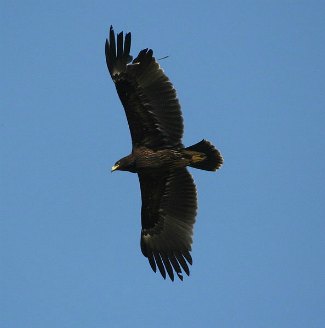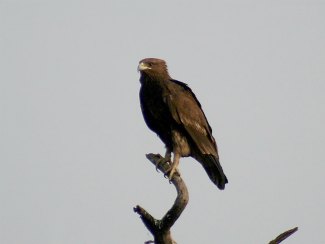Greater Spotted Eagle - Aquila clanga
By Kaippally, CC-BY-SA-3.0, via Wikimedia Commons
Family: Accipitridae
Genus: Aquila
Species: A. clanga
Greater Spotted Eagles are large migratory raptors that live across Europe, the Middle East, Asia, and parts of Africa, in wet lowland forest and forest edges. They have several morph forms, leading to a range of different coloring. They form a monophylum with Aquila hastata (Indian Spotted Eagle), Aquila pomarina (Lesser Spotted Eagle), and Lophaetus occipitalis (Long-Crested Eagle).
Physical Description:
Greater Spotted Eagles are polymorphic with dark, intermediate, and pale morph forms. Dark morphs are black-brown both above and below with pale upperwing coverts and a light, whitish U-shape above the tail. Pale morphs, called fulvescens, have black tails, flight feathers, and greater wing coverts, but are otherwise rufous to buff with dark markings along the breast, flanks, wing edges, and around the eyes. Intermediates are pale with yellow-brown streaking on the upperwing coverts and a buff-colored breast. The cere and feet are yellow, and the eyes are brown.
Juveniles are brown to black with buff spotting and white bands along the upperwings. The tail and flight feathers are tipped with white, except for the outer primary feathers. They reach full adult plumage after 5-6 years.
Greater Spotted Eagles are quiet birds except during the breeding season. Their call is a barking "kyak", which is repeated several times. Listen to a recording.
Size:
Length: 62-74 cm
Wingspan: 160-182 cm
Weight: Male: 1.7-1.9 kg. Female: 1.8-2.5 kg.
Habitat and Distribution:
They occupy lowland forest and forest edges near wet areas, including meadows, bogs, and marshes, along with river-valley woodland. In their wintering grounds they also prefer wetter habitat than most eagles, and are found in river deltas, mangroves, marshes, and lake margins; though in Africa they inhabit semi-arid acacia savannah. They have been recorded as high as 4,000+ meters above sea level in Iran, but they’re more often within a range from 0-1,000 m.
Greater Spotted Eagles live from Northern and Eastern Europe and Russia to Kazakhstan, Iran, and India, and through China, Mongolia, the Malay Peninsula and Sumatra. They are migratory birds and leave their breeding grounds in the winter to head for central and eastern Europe, northern and eastern Africa, the Middle East, the Arabian Peninsula, India, and eastern and southeastern Asia. They are complete long-distance migrants, their range shifting from 66°N to 25°N in summer to 60°N to 0° in winter. One eagle was recorded traveling 4,516 km in less than one month.
There are an estimated 5,000-13,200 individuals, though it is thought likely to be less than 10,000, over a range of 12,800,000 km².
Diet and Hunting:
Greater Spotted Eagles eat frogs, snakes and lizards, waterfowl, fish, insects, carrion, and small mammals up to the size of hares.
They hunt in flight, from a perch, or on the ground. They also steal food from other raptors, including other Greater Spotted Eagles and Milvus migrans (Black Kites).
By J.M.Garg, CC-BY-SA-3.0, via Wikimedia Commons
Reproduction:
Breeding displays are not well known, but do include circling, high soaring, and dives done by the male toward a soaring female. Loud calling usually accompanies the displays. The breeding season is from April-August and November-March in Pakistan.
The nest is built out of sticks and placed in a tree, on a rock, or on the ground. Sometimes the nest of another raptor or Ciconia nigra (Black Stork) is used. It is lined with grass and leaves and is 70 cm-1.1 m across and 1 m deep. 1-3, usually 2, eggs are laid and incubated for 42-44 days. Cainism, also called siblicide, is common and often only one chick survives, though two chicks have fledged in a few cases. Fledging takes 60-67 days, and the young are dependent on their parents for 30 days after that.
Conservation:
Greater Spotted Eagles face threats from habitat destruction in the form of wetland drainage, afforestation, urbanization, agriculture, and floodplain management. They are also in danger from shooting, deliberate and accidental poisoning, disturbance, and nest robbing. The American mink Mustela vison was introduced and has colonized wetlands in Belarus, and may compete with Aquila clanga for food. It is currently unclear if the hybridization between Aquila clanga and Aquila pomarina (Lesser Spotted Eagle) is of conservation concern. Aquila clanga is currently listed as Vulnerable by BirdLife International.
Greater Spotted Eagles are protected in Belarus, Estonia, France, Greece, Latvia, Poland, Romania, Russia, and Thailand. They are the subject of a European Action Plan published in 2000, and a Belarusian National Action Plan. In addition, the International Lesser and Greater Spotted Eagle Group has been established and proposed actions to help conserve the eagles.
Taxonomy:
Based on DNA sequencing of one mitochondrial and two nuclear genes, Aquila clanga, Aquila hastata (Indian Spotted Eagle), Aquila pomarina (Lesser Spotted Eagle), and Lophaetus occipitalis (Long-Crested Eagle) have been shown to form a monophylum. Some authorities have recommended that both Lesser and Greater Spotted Eagles be merged with Lophaetus and that clanga be changed to clangus; however, because Greater Spotted Eagles are still considered part of Aquila by many, they are categorized under that genus here.
Hybridization between Aquila clanga and Aquila pomarina has been reported in all countries where they exist together, except for Russia.
Other Names:
Spotted Eagle, Large Spotted Eagle, Orel volavý (Czech), Stor Skrigeørn (Danish), Bastaardarend (Dutch), Kiljukotka (Finnish), Aigle criard (French), Schelladler (German), Gjallörn (Icelandic), Aquila anatraia maggiore (Italian), Karafutowashi (Japanese), Didysis erelis reksnys (Lithuanian), Storskrikørn (Norwegian), Orlik grubodzioby (Polish), Águila moteada (Spanish), Tai Khangamadoa (Swahili), Större skrikörn (Swedish).
Video of a Greater Spotted Eagle:
References:
http://www.arkive.org/greater-spotted-eagle/aquila-clanga
http://avibase.bsc-eoc.org/species.jsp?avibaseid=BAC4CA22EDCC74E7
http://www.avibirds.com/pdf/B/Bastaardarend4.pdf
BirdLife International (2011) Species factsheet: Aquila clanga. Downloaded from http://www.birdlife.org on 06/12/2011.
http://www.europeanraptors.org/raptors/greater_spotted_eagle.html
Global Raptor Information Network. 2011. Species account: Greater Spotted Eagle Lophaetus clangus. Downloaded from
http://www.globalraptors.org on 6 Dec. 2011
BirdLife International 2011. Aquila clanga. In: IUCN 2011. IUCN Red List of Threatened Species. Version 2011.2.
www.iucnredlist.org. Downloaded on 06 December 2011.
Ferguson-Lees, James, and Christie, David A. Raptors of the World. Houghton Mifflin Company, 2001.
http://www.raptor-research.de/pdfs/a_rp800p/a_rp804_Widespread_hybridization.pdf

